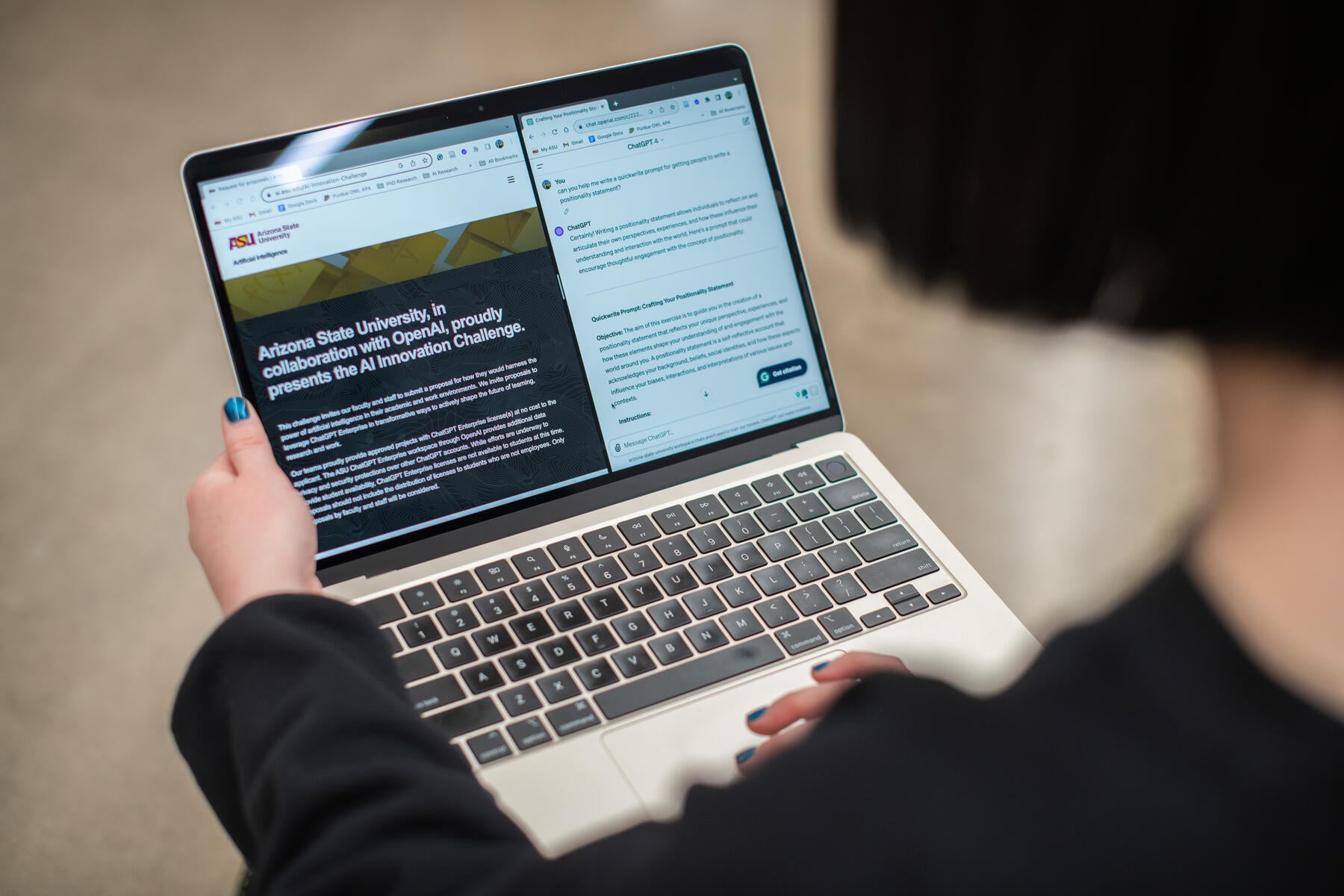
Writing smarter, not harder: An exploration of AI inside the humanities
Just over a month ago, Jacob Greene received a notification he’d been waiting for — his proposal to use ChatGPT Enterprise was approved.
Greene is an assistant professor at Arizona State University’s (ASU) Department of English, where he is teaching a graduate level course called Writing for Scholarly Publication this semester.
For over a year now, Greene has been exploring the impact of generative artificial intelligence (AI) on academic writing practices in the humanities. His work was accelerated this semester with the introduction of ChatGPT Enterprise — a version of the OpenAI chatbot that offers increased levels of privacy to safeguard any data or information a user inputs into the chat — as part of the AI Innovation Challenge the university launched this semester.
“Our interdisciplinary graduate research team will leverage ChatGPT Enterprise to engage in innovative approaches to academic writing, curriculum design and systematic literature reviews,” Greene explained. “Students are engaging in reflective writing and chat conversation analysis to better understand the role of research writing on their writing practices.”
Greene’s students – who are all participants in the AI Innovation Challenge initiative – shared some of the ways in which they use ChatGPT Enterprise to improve their writing processes for class.
Ways that AI supports scholarly writing
Greene’s course is designed to teach scholarly writing. A key component is to develop an academic argument, which is broken down into four parts: argument (claim), exigence (motivation), evidence (support) and stakes (why it matters).
For scholarly writing, the article's abstract should reflect all four parts. “I was struggling to explain my argument and exigence,” shared Kylie Frontczak, a first-year doctoral student.
Frontczak explained that this is where a tool like ChatGPT Enterprise can help. By inputting these sections into the chatbot, she can tailor a prompt to have the chatbot reiterate her points for argument and exigence, and define who her intended audience is.
“I can use the chatbot to provide a feedback loop that allows me to continue to refine and better articulate my writing,” Frontczak noted.
In this instance, the tool becomes a real-time tutor. And, as Frontczak noted, the bot doesn’t replace her as the writer: “I gave [the chatbot] my own ideas so it’s not recreating anything new.” Rather, the tool can act as an additional editor.
Fellow graduate student Madison Horgan built on this idea, explaining how the tool can augment our skills. “ChatGPT [Enterprise] has reduced the barrier of entry to tasks I haven’t done before, especially when I don’t know where to start,” Horgan explained.
In addition to ChatGPT Enterprise helping Horgan get started on tasks, she also uses it to better communicate with others when incorporating feedback from peer review during the scholarly publication process. Horgan mentioned that when she’s working through others’ feedback – which she might not always immediately agree with – she uses ChatGPT Enterprise to better understand the reviewer’s perspective and ask for advice on how to revise her own work and respond to those statements using a respectful academic tone.
Maximizing ChatGPT Enterprise’s features
For graduate students like Layne Ilderton, who uses ChatGPT everyday, access to the Enterprise version meant new opportunities to train her chatbot — or instance of ChatGPT Enterprise — to tailor better responses that simulate a more human, conversational interaction. Ilderton personalizes her chatbot by sending inputs and sharing preferred outputs; for example, she is training her chatbot to interact with her using emojis.
“I am a verbal processor, and I need this object tool to talk to and interact with about my studies,” said Ilderton. “I have conversations with my bot about my bot. I upload assignments and ask the bot specific questions about my work.”
Through ChatGPT Enterprise functionality like fine tunes and the playground, Ilderton is able to tailor her chatbot and see constant improvement – the more she teaches and prompts the bot, the better the outcomes will be.
Privacy around ASU data was once a challenge for faculty, staff and students with the free version of ChatGPT. With the Enterprise license, users can upload large documents and have much longer chat contexts, allowing them to use generative AI to help clarify language and structure.
“Being able to give [ChatGPT Enterprise] bigger inputs has been the biggest game changer for me,” said Frontczak. “And it’s also been a lot better with citations. It can generate citations for me and that’s something I struggled with more in the open model.”
How AI serves as a writing companion
With a wide range of AI literacy and adoption in the class, Greene shares that everyone is still figuring out how ChatGPT Enterprise can be useful. But the main area in which students find value with the tool is idea generation for structuring their writing and determining what content to include. “This doesn’t remove your voice, but offers ideas for what might be missing or avenues to explore,” said Greene. “It serves the role of collaborator.”
He went on to explain that this initiative only advances creativity and efficiency in interdisciplinary scholarly endeavors and “underscores our commitment to ethical AI use and positive impact, aligning with ASU's goals to foster responsible integration of AI.”
Once their trial period with ChatGPT Enterprise ends, Greene and his class will compile their experiences into a collaborative research article designed to give academics some insight into the potential affordances and limitations of AI for their own academic writing.
Discover more about the AI Innovation Challenge at ASU.